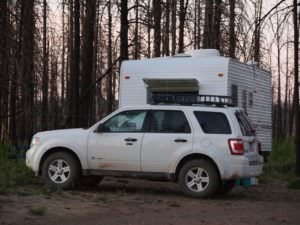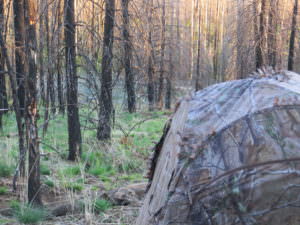Helping Save Mexican Gray Wolves (#3) – base camp & the blind
Plans are being made for the first release IN FIVE YEARS of Mexican gray wolves into the wild! Nearly exterminated in the wild during by the 1930s, the Mexican wolf remains one of the most endangered mammals in North America. In May, Wolf Haven’s Director of Animal Care, Wendy Spencer assisted in the care & observation of two wolves scheduled for future release.
Once we were briefed at the Alpine office, Erin and I followed Allison, an AZGF employee out to the pen site. Located approximately an hour and a half outside of Alpine, we wound our way up into the hills, into the heart of where the Wallow fire ripped through in May of 2011, burning 538,000 acres. Eventually we turned off onto a dusty forest service road which we followed for about 18 miles until we came upon the travel trailer that would be our home base for the next week.
It was total luxury- not like any other back country backpacking that I had done- there were beds, solar power, propane heat, a refrigerator and stove (but no plumbing)- 5 star camping! We were given the essentials- water, a bathroom shovel, telemetry equipment and a hand held radio (in case of an emergency) and a log book for keeping track of our observations. Then, before dusk set in, we hiked on foot to the blind where we would be observing the wolves.
As the crow flies, the blind was about a mile from camp, but in order to come around the back side of the blind and be as unobtrusive as possible, we took more of a round- about path which lead us up several switchback trails to the top of a ridge and then down the other side. The blind was just a camouflaged pattern tent set up on the hillside about 300 feet from the pen. Inside the blind there was a spotting scope and a chair- everything we needed for watching wolves. That first day we did not stay long- perhaps only 10 minutes- just enough time to see the layout of the pen and get a glimpse of the wolves and their distinguishing marks so that we could tell the male apart from the female (i.e: radio collar color, coat color and pattern). Because there were 3 of us and the prevailing wind was coming from behind us, the wolves knew the moment we crested the ridge. They continued to keep a nervous eye on us the entire time we were there so as soon as we got our visuals, we quietly slipped away and returned to camp.
Back at camp we received our detail: telemetry readings every 2 hours, observation at the blind by one person only for two consecutive hours a day and even though the area was closed to the public, turkey hunting season still had a few weeks to go, so we needed to keep an eye out for anyone who might accidentally (or intentionally) wander into the area and inform them of the closure and ensure that they turned around…………(to be continued)





Seriously a lot of very good material.
Cheers. Great stuff!
Thank you for your input. Our Director of Animal Care was so moved by the entire experience that she wrote over 5,000 words about that week in Arizona pen sitting Mexican gray wolves.
Thank you! A lot of material!